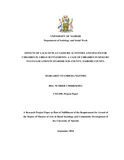| dc.description.abstract | In the past 20 years, urban areas in Kenya have had dramatic growth due to increased population growth and rural urban migration. Despite the fact that urbanism is used many times as an indicator of development, it has also led to development and growth of slum leading to congestion and lack of play spaces for children. Most informal settlements in the world and indeed in Kenya are congested as every space is coveted by many to meet their needs. Informal settlements all over the world are characterized by congestion and lots of crime and insecurity. Parents and other care givers feel insecure to let their children engage in unstructured play outside and prefer to engage them in indoor games. However, indoor games do not have the same magnitude of invoking creativity and innovation, cognitive development and knowledge of general societal issues as outside unstructured play. This study focused on Mukuru Nyayo informal settlements of Starehe Sub County in Nairobi County. The study sought examine both positive and negative impacts of lack of place spaces on child development in Mukuru Nyayo location, Mukuru Slums, Nairobi County. The specific objectives were to establish the extent to which unavailability of play space affects school academic performance of children in Mukuru Nyayo Location of Nairobi County, To assess the extent to which play activities influences creativity and innovation for children in Mukuru Nyayo Location of Nairobi County; To determine the influence of play activities on children’s general knowledge about society in Mukuru Nyayo Location of Nairobi County. The findings from this study may provide a useful depository of relevant data which is important to the government policy makers in relevant ministries. It could also be useful to the Vision 2030 Secretariat especially under the social pillar. The ministry in charge of education will also benefit from the findings and perhaps open up some of its government sponsored schools in the informal settlements to become child friendly centres which can offer space to children over the weekend and during the long vocation break. The scope of this study was the children from Mukuru Mukuru Nyayo location of Nairobi County. This study took a look at theories of child development, socialization and the Montessori theory of normalization. The total population was 1492 children(class five to eight) drawn from three public primary schools whose catchment areas include formal and informal settlements of Mukuru Nyayo location of Starehe Sub-County of Nairobi County. The sample size was 202 respondents i.e 14% of school registered children as suggested by Cooper and Schindler, 2003. Primary data was collected using questionnaires. At the same time secondary data was captured from school records. The findings indicate that type of play activities and where play activities take place (indoor/outdoor) affects academic performance of the child, general knowledge of issues in the community and creativity/innovation of a child. According to this study, higher proportions of children who engage more in outside activities performed better in their academics compared to those who engaged in indoor activities. Majority of the children who played in the field and those who had indicated that they played outside the house on the corridors scored a mean average of above 300 marks in their examinations at 52.2% (n= 48) and 49.2%(n=29) respectively while the majority of those who played in the house 61.5 % (n=8) were either average performers (scored between 200-300 marks) or scored below 200 marks in their academic performance. The conclusion was that availability/lack of playing space has negative effect to academic performance, creativity
xiv
and general knowledge of a child. The government needs to enforce implementation of policies governing urbanization in Kenya. This will ensure that public land is not grabbed by private developers who have no interest in adhering to controlled development as advised by the urban policies. Development partners need to support the government efforts of slum upgrading in the informal settlements. Such will ensure that there is proper planning of dwellings in the informal settlements to allow for many social amenities such as play spaces for children that are lacking. The researcher suggested further research to investigate play activities children who engage in indoor games involve themselves in, specifically on what video/games and other programmes children watch and their effect to children’s behavior. A comparative study with similar objectives on lack of play spaces for rural versus urban children would shed more light on this important topic of child development. | en_US |



